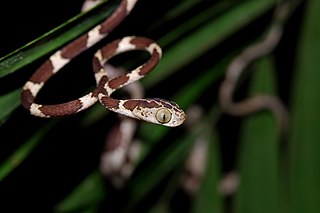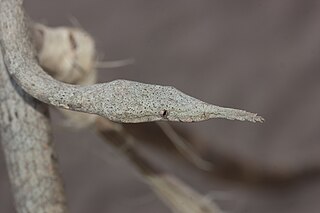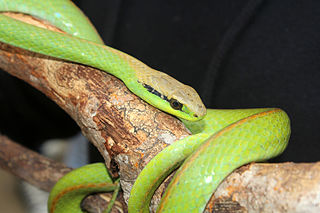
Imantodes cenchoa, also known commonly as the blunthead tree snake, the neotropical blunt-headed tree snake, and the fiddle-string snake, is a species of mildly venomous, rear-fanged snake in the family Colubridae. The species is native to Mexico, Central America, and South America.

The military ground snake is a species of snake in the family Colubridae, which is endemic to South America.

Langaha madagascariensis is a medium-sized non-venomous highly cryptic arboreal species. It is endemic to Madagascar and found in deciduous dry forests and rain forests, often in vegetation 1.5 to 2 meters above the ground.

Bothrops cotiara is a species of venomous snake in the family Viperidae. It is endemic to Brazil and Argentina.
Atractus albuquerquei, commonly known as the Albuquerque ground snake, is a species of small burrowing snake in the family Colubridae. The species is endemic to South America.

Naja nigricincta is a species of spitting cobra in the genus Naja, belonging to the family Elapidae. The species is native to the deserts and drier regions of southern Africa. The species is largely nocturnal, and is often found while crossing roads at night. There are two recognized subspecies.

Philodryas olfersii is a species of venomous snake in the family Colubridae. The species is endemic to South America.

Oxyrhopus guibei is a species of snake in the family Colubridae. The species is endemic to South America. It is often called the false coral snake, but this common name can refer to any of a long list of other species, genera, and even entire families of snakes. Many nonvenomous snakes have evolved coloration that mimics that of venomous true coral snakes, a trait which helps them avoid predation.

Dipsadinae is a large subfamily of colubroid snakes, sometimes referred to as a family (Dipsadidae). Species of the subfamily Dipsadinae are found in most of the Americas, including the West Indies, and are most diverse in South America. There are more than 700 member species.

Philodryas patagoniensis, also known as the Patagonia green racer, is a species of rear-fanged (opisthoglyphous) venomous snake in the family Colubridae. The species is endemic to cis-Andean South America from northern Argentina to northeastern Brazil; despite its name, most of its range is outside Patagonia.

Atractus pantostictus is a species of snake in the family Colubridae.

Boie's ground snake is a nocturnal and semi-fossorial snake species in the Colubridae family. Like the other members of the Atractus genus, its diet is composed predominantly of earthworms, which it actively hunts in the leaf litter of the primary and secondary rainforests it inhabits. The IUCN lists the species as 'Least Concern' because of its wide distribution, including in protected areas.

Phalotris lemniscatus is a species of venomous snake found in South America. It's usually known as Pampeana black headed snake or Duméril's diadem snake.
Atractus alphonsehogei, also known commonly as Alphonse's ground snake, is a species of snake in the family Colubridae. The species is endemic to Brazil.
Atractus bocki, Bock's ground snake, is a species of snake in the family Colubridae. The species can be found from Bolivia to Argentina.

Atractus emmeli, also known commonly as Emmel's ground snake and Boettger's ground snake, is a species of snake in the family Colubridae. The species is native to northwestern South America.
Atractus francoi, also known commonly as cobra-da-terra in Brazilian Portuguese, is a species of snake in the family Colubridae. The species is endemic to Brazil.
Atractus snethlageae is a species of snake in the family Colubridae. The species can be found in Brazil, Suriname, Colombia, Bolivia, Peru, Ecuador, and Argentina.
Pseudoboa haasi, also known commonly as the Paraná false boa, is a species of snake in the subfamily Dipsadinae of the family Colubridae. The species is native to Argentina and Brazil.
Psomophis genimaculatus, also known commonly as the spirit diminutive snake, the spirit ground snake, and cobra-cabelo in Brazilian Portuguese, is a species of snake in the subfamily Dipsadinae of the family Colubridae. The species is endemic to South America.














